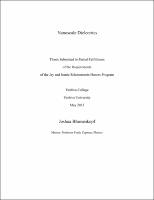Please use this identifier to cite or link to this item:
https://hdl.handle.net/20.500.12202/4107Full metadata record
| DC Field | Value | Language |
|---|---|---|
| dc.contributor.author | Blumenkopf, Joshua | |
| dc.date.accessioned | 2018-11-06T19:16:58Z | |
| dc.date.available | 2018-11-06T19:16:58Z | |
| dc.date.issued | 2013-05 | |
| dc.identifier.uri | https://hdl.handle.net/20.500.12202/4107 | |
| dc.identifier.uri | https://ezproxy.yu.edu/login?url=https://repository.yu.edu/handle/20.500.12202/4107 | |
| dc.description | The file is restricted for YU community access only. | |
| dc.description.abstract | The concept of a dielectric constant is ill-posed in systems at the nanoscale because the classical definition of a dielectric requires the presence of a very large number of elemental dipole particles. Here we asses the validity of such a definition in light of new technologies that probe matter at the nanoscale. We find that repulsive force regions, non existent for concave macroscopic dielectrics interacting with charged objects, do appear for discrete matter. We also explore the connection between the e↵ective macroscopic dielectric constant and the microscopic atomic polarization at the nanoscale. To do this, we explicitly considered a discrete approach that directly takes into account the internal geometric structure of a nanocluster. As a preliminary case to benchmark the accuracy of our method for solving electrostatic potential problems with cylindrical symmetry, we studied the problem of a single charged particle placed along the symmetry axis of a neutral metallic hemispherical shell, which surprisingly has a repulsive region, and obtained agreement with the results in [1].To tackle our main problem of directly modeling a nanoscale spherical dielectric using its microscopic structure we considered an explicit collection of discrete dipoles (arranged as “dipolar rings”) to probe its composite reaction to external fields. We find that the behavior of this discrete system sometimes departs from the continuum case, for example when the external charge is close to the nano system, or when the polarizabilty, ↵, is large, where we find a repulsive region. | en_US |
| dc.description.sponsorship | Jay and Jeanie Schottenstein Honors Program | en_US |
| dc.language.iso | en_US | en_US |
| dc.publisher | Yeshiva College | en_US |
| dc.rights | Attribution-NonCommercial-NoDerivs 3.0 United States | * |
| dc.rights.uri | http://creativecommons.org/licenses/by-nc-nd/3.0/us/ | * |
| dc.subject | Nanoelectronics. | en_US |
| dc.subject | Nanoscience. | en_US |
| dc.subject | Nanotechnology. | en_US |
| dc.subject | Nanostructured materials. | en_US |
| dc.subject | Nanoparticles. | en_US |
| dc.subject | Dielectrics. | en_US |
| dc.title | Nanoscale Dielectrics | en_US |
| dc.type | Thesis | en_US |
| Appears in Collections: | Jay and Jeanie Schottenstein Honors Student Theses | |
Files in This Item:
| File | Description | Size | Format | |
|---|---|---|---|---|
| Joshua-Blumenkopf.pdf Restricted Access | 7.52 MB | Adobe PDF |  View/Open |
This item is licensed under a Creative Commons License

